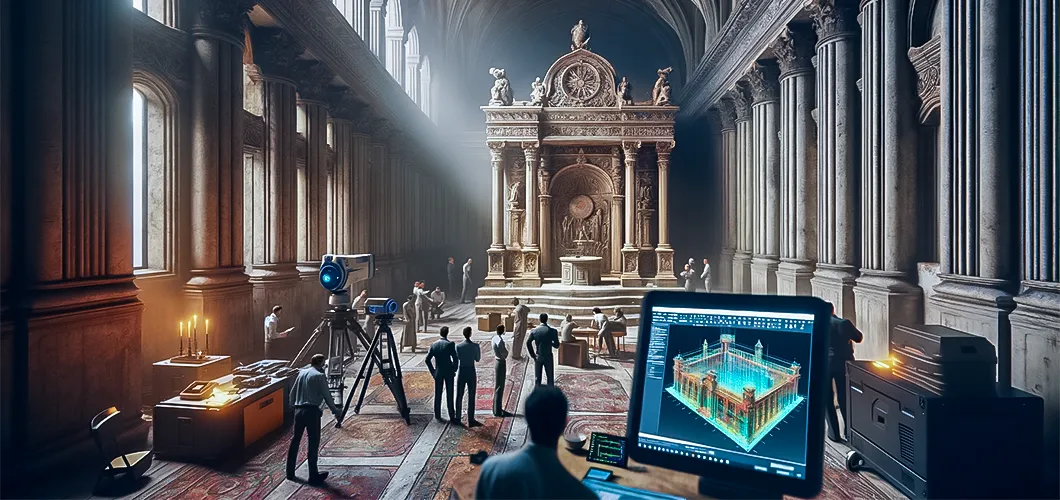
Streamlining Historic Preservation with Scan to BIM Technology
Historic preservation is a delicate balance of maintaining the authenticity of heritage sites while ensuring their longevity and usability. Traditional methods of documentation and restoration often fall short of providing the precision and comprehensive data needed for such projects. However, advancements in technology, particularly Scan to BIM (Building Information Modeling), are revolutionizing this field.
Scan to BIM historic preservation technology streamlines processes, offering detailed insights and facilitating more accurate and efficient restoration processes.
Understanding Scan to BIM Technology
Point Cloud Modelling Scan to BIM involves using 3D laser scanning technology to capture the precise dimensions and details of a physical structure. This process generates a point cloud, a collection of data points in space that represent the surface of the scanned object. The point cloud data is then imported into BIM software, where it is used to create a highly accurate digital model of the structure. This model can include both the geometry and spatial relationships of the building components, providing a comprehensive digital representation.
Scan to BIM Historic Preservation
This is how Scan to BIM Historic Preservation technology is helping to streamline historic preservation efforts:
Enhancing Documentation Accuracy
One of the primary benefits of Scan to BIM historic preservation technology is the enhanced accuracy of documentation. Traditional methods, such as hand measurements and 2D drawings, can be prone to errors and often lack the detail required for intricate historic structures. 3D laser scanning captures millions of data points, ensuring that even the smallest details are recorded with precision. This high level of accuracy is crucial for preserving the structure’s historical integrity, as it allows for the exact replication of original features during restoration.
Facilitating Detailed Analysis
Scan to BIM technology enables detailed analysis of historic structures, which is essential for understanding their condition and planning restoration efforts. The digital model created from the point cloud data can be used to perform structural analysis, identifying areas of deterioration or weakness. It can also help in assessing the impact of previous restorations or modifications. This detailed analysis aids preservationists in making informed decisions about the best methods for restoration and conservation, ensuring that interventions are both effective and minimally invasive.
Improving Restoration Planning

Restoration planning is a complex process that requires careful consideration of various factors, including structural integrity, materials, and historical accuracy. Scan to BIM technology simplifies this process by providing a comprehensive and detailed digital model of the structure. Preservationists can use this model to visualize the entire project, identify potential challenges, and develop detailed restoration plans. This visualization helps in coordinating different aspects of the restoration process, from material procurement to on-site execution, leading to more efficient and accurate outcomes.
Enhancing Collaboration
Historic preservation projects often involve multiple stakeholders, including architects, engineers, conservators, and regulatory authorities. Effective collaboration among these parties is crucial for the success of the project. Scan to BIM technology enhances collaboration by providing a single, comprehensive digital model that can be accessed and shared by all stakeholders. This shared model ensures that everyone is working with the same information, reducing misunderstandings and discrepancies. It also facilitates better communication and coordination, as stakeholders can easily visualize and discuss different aspects of the project.
Supporting Sustainable Preservation
Sustainability is becoming an increasingly important consideration in historic preservation. Scan to BIM technology supports sustainable preservation by providing detailed data that can be used to plan and execute energy-efficient and environmentally friendly restoration practices. For example, the digital model can be used to simulate the energy performance of the building and identify opportunities for improving its thermal efficiency. It can also help in sourcing sustainable materials and minimizing waste during the restoration process. By promoting sustainable practices, Scan to BIM technology helps preserve not only the historical value of the structure but also its environmental footprint.
Also learn: How BIM Improves Sustainability in Construction Projects?
Future Outlook
The future of historic preservation is closely tied to advancements in technology, and Scan to BIM is at the forefront of this transformation. As the technology continues to evolve, we can expect even more sophisticated applications that will further streamline the preservation process. For instance, the integration of Scan to BIM with augmented reality (AR) and virtual reality (VR) could provide preservationists with immersive visualization tools, enhancing their ability to plan and execute restorations. Additionally, advancements in AI and machine learning could enable more automated analysis and detection of structural issues, making the preservation process even more efficient.
In conclusion, Scan to BIM historic preservation is nothing short of a revolution by providing precise documentation, detailed analysis, and improved collaboration. As this technology continues to advance, it will play an increasingly vital role in preserving our cultural heritage for future generations. Preservationists who embrace Scan to BIM technology will be better equipped to tackle the complex challenges of historic preservation, ensuring that these treasured structures are maintained with the utmost care and accuracy.
Related: BIM for Heritage Conservation
